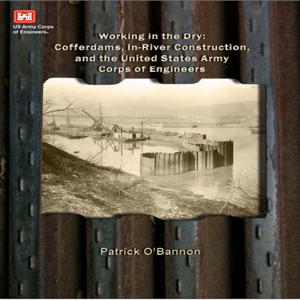Working in the dry: cofferdams, in-river construction, and the united states army corps of engineers
by Patrick W. O’Bannon, Ph.D
Working in the dry- This project enjoyed the support and assistance of many people.
Conrad Weiser, U.S. Army Corps of Engineers Pittsburgh District, served as the Contracting Officer’s Technical Representative for the project.
He identified Corps’ personnel that could contribute to the study, provided illustrations, and oversaw the entire process-Working in the dry.
Charles Parrish of the Corps’ Louisville District, and Matthew Pearcy with the Corps’ Office of History helped point the research effort in fruitful directions and provided copies of hard-to-find sources.
At the U.S. Army Corps of Engineers’ Engineer Research and Development Center (ERDC) in Vicksburg, Mississippi, Milton Myers served as a gracious host and introduced me to librarian Helen T. Ingram who retrieved dozens of reports and documents for my review.
Mr. Myers also arranged for oral interviews with senior ERDC staff, who generously shared their time and knowledge of cofferdam design and analysis.
The staff at numerous libraries and research institutions helped ferret out obscure sources and illustrations.
Thomas Brankamp at Woolpert, Inc., served as the principal liaison between the Corps and Gray & Pape. At Gray & Pape, Brandon McCuin and Mitchell Sipus assisted in the research effort, Carly Meyer prepared the graphics, and Madonna Ledford and Julisa Meléndez edited the manuscrip.
Cofferdams are not an invention of the industrial age. Among the earliest written descriptions of cofferdams are those of Marcus Vitruvius Pollio, a Roman writer, architect, and engineer, active during the first century B.C.





Reviews
There are no reviews yet.